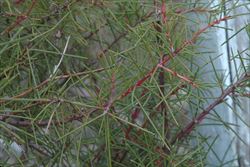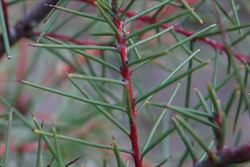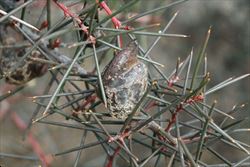Click on images to enlarge

habit (Photo: Rob and Fiona Richardson)

stems and needle-like leaves (Photo: Rob and Fiona Richardson)

close-up of needle-like leaves (Photo: Rob and Fiona Richardson)

flower clusters (Photo: Rob and Fiona Richardson)

close-up of flowers (Photo: Rob and Fiona Richardson)

mature fruit (Photo: Rob and Fiona Richardson)

old fruit (Photo: Rob and Fiona Richardson)

the very similar species known as bushy needlewood, Hakea decurrens (Photo: Sheldon Navie)
Scientific Name
Hakea sericea Schrad. & J.C. Wendl.
Synonyms
Banksia acicularis (Sm. ex Vent.) J. Parm.Banksia tenuifolia Salisb.Conchium aciculare Sm. ex Vent.Conchium compressum Sm.Hakea acicularis (Sm. ex Vent.) KnightHakea acicularis (Sm. ex Vent.) Knight var. smithii Endl.Hakea tenuifolia (Salisb.) BrittenHakea tenuifolia (Salisb.) Britten var. tenuifolia Domin
Family
Proteaceae
Common Names
bushy needlewood, needle bush, needlebush, silky hakea
Origin
Native to some parts of eastern Australia (i.e. south-eastern Queensland and eastern New South Wales). It grows naturally in dry sclerophyll forests and heathlands, in coastal and sub-coastal districts, from Coffs Harbour in northern New South Wales south to the Victorian border. It is also native to a few isolated locations in south-eastern Queensland.
Naturalised Distribution
Occasionally naturalised in south-eastern South Australia and southern Victoria.
Also naturalised on Norfolk Island and overseas in southern Europe, South Africa and New Zealand.
Notes
Silky hakea (Hakea sericea) is regarded as an environmental weed in Victoria and South Australia. In South Australia it is only noted, by the state herbarium, to be sparingly naturalised along roadsides and in sclerophyll forests in the Southern Lofty Mountains region. However, it regularly appears on local and regional environmental weed lists in this area and is even described as being a "common environmental weed" in the Adelaide region.
In Victoria, where it is known from a few scattered locations (e.g. at Anglesea and along the Carlisle River), it is occasionally regarded as a potentially significant environmental weed. Silky hakea (Hakea sericea) appears on some local environmental weed lists in this state (e.g. in the City of Hume) but its impact and distribution may be underestimated. This is because it has often been confused with the local native species known as bushy needlewood (Hakea decurrens).
Silky hakea (Hakea sericea) is also invasive in New Zealand and South Africa. It is particularly troublesome in South Africa, where it is a major weed in fynbos vegetation in the southern and south-western Cape Province regions. In New Zealand, research has shown that this early successional species may eventually be replaced by natives once again, if no further disturbance events (i.e. fires) occur in invaded areas.

